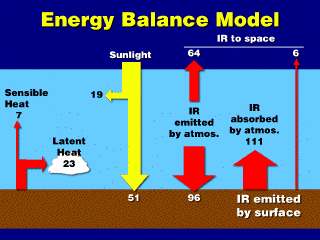 We are going to see if we have radiative
equilibrium, from the incoming sunlight (51% absorbed by the ground, 19%
absorbed by the atmosphere), the outgoing IR radiation, and the atmospheric
IR that produces the greenhouse effect.
We are going to see if we have radiative
equilibrium, from the incoming sunlight (51% absorbed by the ground, 19%
absorbed by the atmosphere), the outgoing IR radiation, and the atmospheric
IR that produces the greenhouse effect. We are going to see if we have radiative
equilibrium, from the incoming sunlight (51% absorbed by the ground, 19%
absorbed by the atmosphere), the outgoing IR radiation, and the atmospheric
IR that produces the greenhouse effect.
We are going to see if we have radiative
equilibrium, from the incoming sunlight (51% absorbed by the ground, 19%
absorbed by the atmosphere), the outgoing IR radiation, and the atmospheric
IR that produces the greenhouse effect.
The greenhouse effect makes the Earth's surface emit more than the 51 units it receives from the sun. Some of this IR goes directly to space (6 units); the rest of the 117 emitted units (111) is absorbed by the atmosphere, which then emits the energy as IR both to space (64 units) and to the Earth (96 units). The total IR out to space (64 + 6 = 70 units) is equivalent to the net solar radiation absorbed (100 incoming - 30 reflected/scattered due to albedo). Thus, the entire Earth-atmosphere system is in radiative equilibrium with the sun and space.
Unfortunately, the surface of the
Earth receives a total of 147 units of radiation (51 solar + 96 IR from atmosphere)
while it emits only 117 (6 that goes directly to space and 111 that gets absorbed
by the atmosphere), so the surface of the Earth is out of radiative balance.
Normally, this would cause the Earth to heat up and burn because of the continuous
net absorption of energy. Fortunately, there are other methods for getting rid
of the excess absorbed energy. Sensible
heat transfer, which is heat conducted to the air from the ground and convected
upward, and latent
heat transfer, which occurs when water evaporates from the ground, is transported
upwards, and condenses out at clouds. These contributions are small relative
to the total radiation burden, but they are significant and necessary.